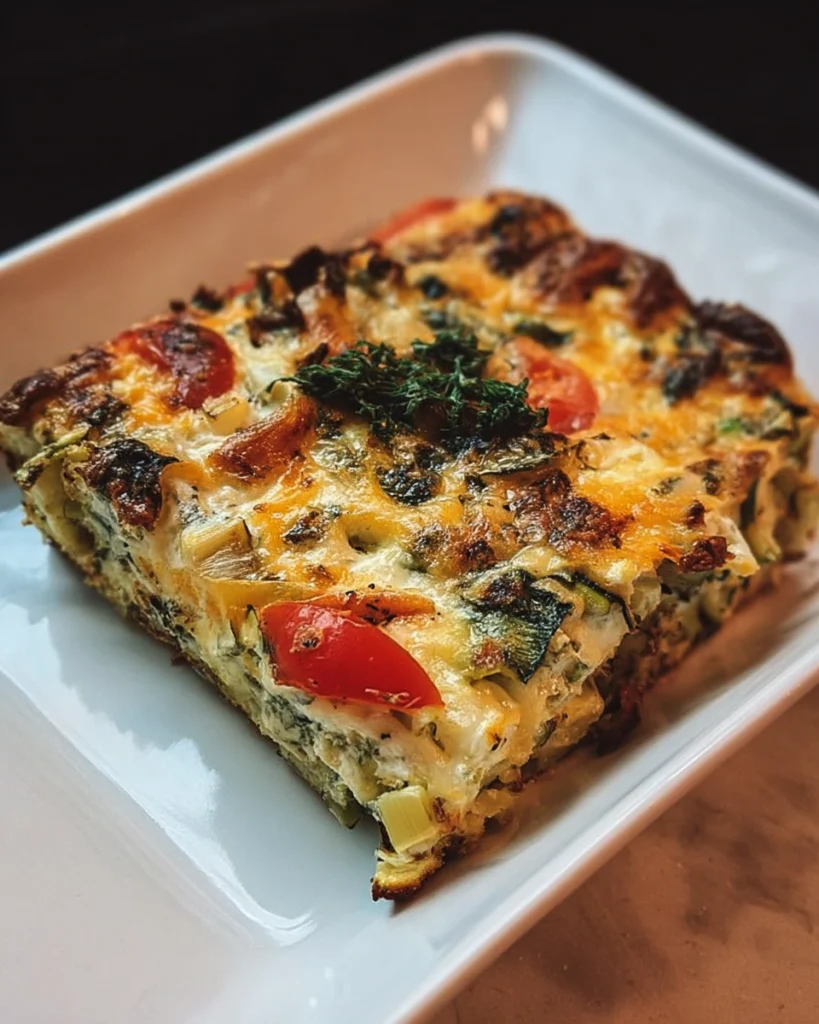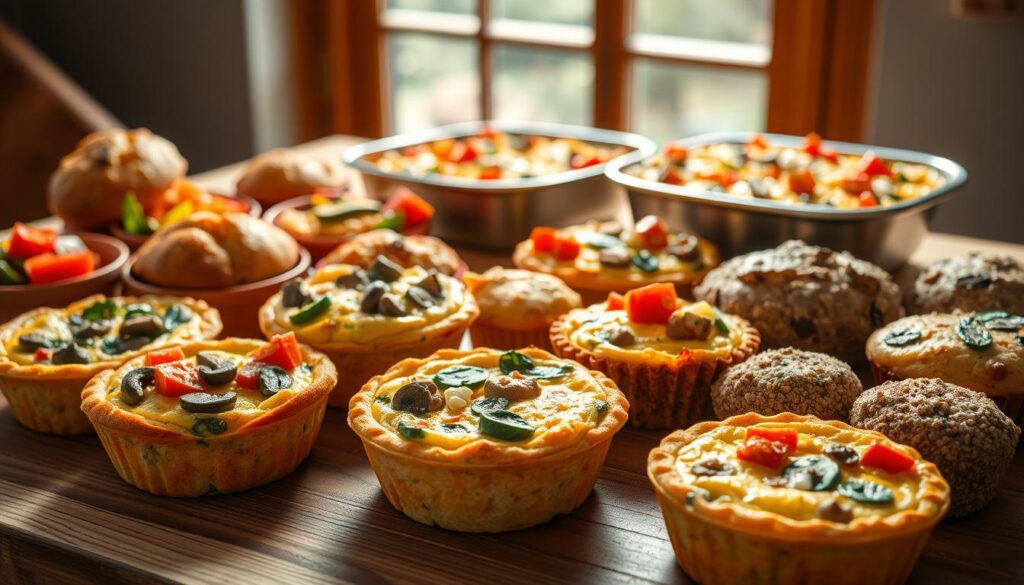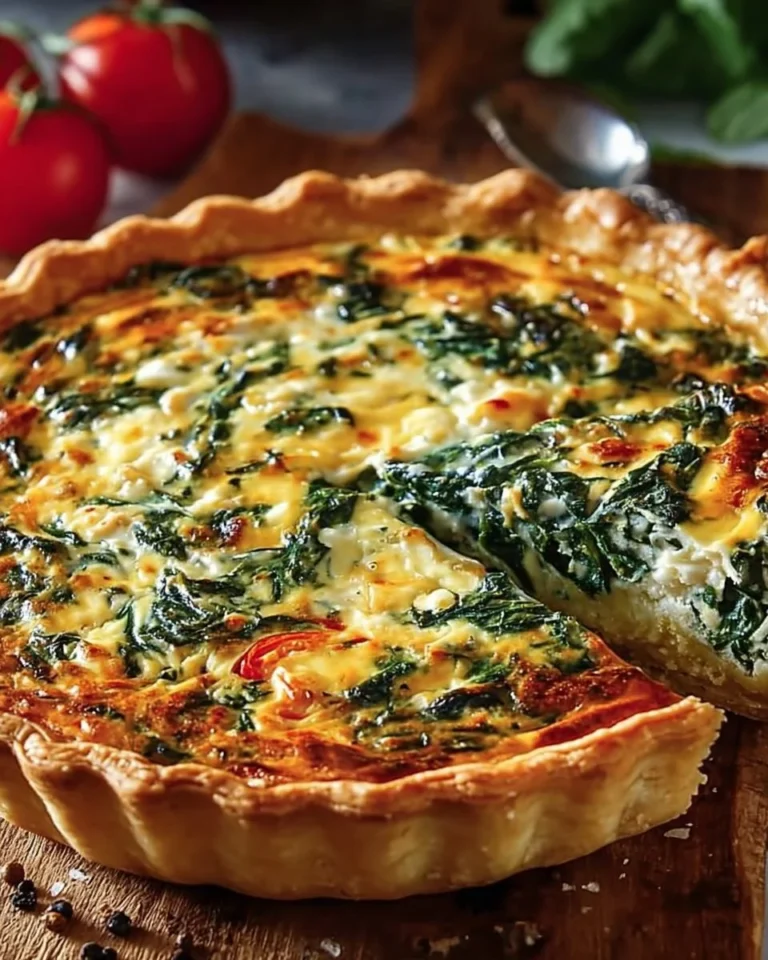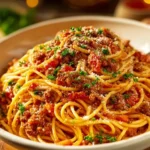Ever woke up to the smell of a dish baking? It fills your home with warmth and nourishes your body. The Baked Vegetable and Egg Casserole is more than breakfast. It’s a mix of flavors and healthy ingredients that brightens your day.
Imagine a dish that’s both tasty and good for you. This egg casserole with veggies combines colors and nutrients with protein. It’s a meal that’s as enjoyable as it is healthy. By learning this recipe, you can add more healthy dishes to your meals.

Table of Contents
Key Takeaways
- The Baked Vegetable and Egg Casserole offers a nutritious start to your day.
- Combining eggs with a variety of vegetables enhances both flavor and health benefits.
- This dish is versatile; perfect for breakfast, brunch, or dinner.
- Incorporating more vegetables in your meals can significantly boost your overall diet.
- Mastering the recipe allows you to enjoy healthy meals with ease.
Introduction to Baked Vegetable and Egg Casserole
Casseroles are a hit in American homes for their quick and easy meals. The baked vegetable and egg casserole is a tasty and healthy breakfast option. It mixes easy-to-bake veggies with eggs, making a satisfying and nutritious dish.
This casserole is perfect for breakfast, brunch, or any time you want something comforting. It’s easy to make, making it great for busy mornings or weekend meals. Explore the world of baked vegetable and egg casseroles and see how simple ingredients can make a delicious meal for all.

Benefits of Including Vegetables in Breakfast Casseroles
Adding vegetables to your breakfast casseroles is a smart move. It makes your meal not only tasty but also healthy. This is great for those looking for nutritious and filling meals. Let’s dive into why veggies are a good choice for breakfast.
Boosting Nutritional Value
Vegetables are full of vitamins and minerals that are good for you. Adding different veggies to your casserole makes it even healthier. Spinach and bell peppers, for example, add color and antioxidants.
These antioxidants fight inflammation and boost your immune system. So, your breakfast becomes both tasty and good for you.
Increasing Fiber Intake
Vegetables also increase the fiber in your casserole. Fiber is key for a healthy digestive system and can help with weight control. It keeps you full longer, so you’re less likely to snack on unhealthy foods.
Enjoying a ww vegetable casserole means you get a filling meal that’s also high in fiber.

| Vegetable | Nutritional Benefits | Fiber Content (per cup) |
|---|---|---|
| Spinach | Rich in vitamins A, C, K, and iron | 0.7 g |
| Bell Peppers | High in vitamin C and antioxidants | 2.5 g |
| Zucchini | Low in calories and rich in potassium | 1.0 g |
| Mushrooms | Source of B vitamins and minerals | 0.7 g |
Key Ingredients for Your Baked Vegetable and Egg Casserole
Choosing the right ingredients is key for a delicious baked vegetable and egg casserole. This dish lets you add different veggies to make it tasty and healthy. It’s a great way to start your day with a protein-rich breakfast.
Choosing the Right Vegetables
Choose vibrant veggies for color and nutrition. Some top picks are:
- Spinach
- Mushrooms
- Bell peppers
- Broccoli
Many stores sell these veggies pre-cut, saving you time. Try different veggies to find your favorite mix.
Eggs: The Perfect Protein Source
Eggs are the heart of a good casserole. They add protein to keep you full. Eggs also make the dish fluffy when baked.
Types of Cheese to Use
The right cheese can make your casserole amazing. Here are some great cheese options:
- Cheddar
- Swiss
- Mozzarella
- Feta
Using different cheeses creates a rich flavor. Choose your favorite to make the dish irresistible.
Choosing Your Base: Potatoes vs. Other Carbs
Creating the perfect baked vegetable and egg casserole starts with the base. Potatoes are often the top choice because they’re starchy. This makes them a great foundation for flavor and texture. Yukon Gold potatoes are a standout because they’re creamy, making them a hit in many kitchens.
Why Potatoes Work Well
Potatoes, like Yukon Gold, make a hearty base for breakfast. They pair well with vegetables and eggs, adding creaminess to each bite. The starch in potatoes helps hold the casserole together, making it sturdy. Their mild taste lets other flavors shine, making them perfect for casseroles.
Alternatives to Potatoes
Want to try something different? Sweet potatoes add color and sweetness, plus extra nutrients. Quinoa is a gluten-free option that’s high in protein, great for health-focused eaters. These alternatives offer a comforting base that suits various diets.
How to Prepare Your Baked Vegetable and Egg Casserole
Preparing a delicious baked vegetable and egg casserole is easy. Start by preheating your oven to 375°F (190°C). This ensures your casserole cooks evenly, making it beautifully set.
Next, use a 9×13 inch baking dish and lightly grease it. You can use cooking spray or olive oil. This prevents sticking and makes serving easier. Using pre-cut vegetables saves time, making it an easy recipe.
Layer your ingredients in the baking dish. Start with a layer of vegetables like spinach, bell peppers, and zucchini. Then, add a layer of beaten eggs mixed with seasonings. You can also add cheese for a creamier texture. Keep alternating layers until you reach the top.
After you’ve assembled everything, put the dish in the oven. Bake for about 30-35 minutes. The eggs should be fully set and the top golden. Watch it closely in the last few minutes to avoid overcooking.
Once baked, let the casserole cool for a few minutes. This step enhances flavors and makes cleaner slices. Enjoy your tasty casserole, great for breakfast, brunch, or a quick dinner!
Cooking Methods: Oven vs. Slow Cooker
Choosing the right cooking method is key to a tasty baked vegetable and egg casserole. You can pick between oven baking or slow cooker cooking. Each method has its own benefits, fitting different cooking styles and schedules.
Benefits of Baking in the Oven
Oven baking gives you a golden, crispy top on your casserole. It heats evenly, making sure all ingredients are cooked well together. The oven’s dry heat caramelizes the vegetables, boosting their taste.
This method also creates a texture that’s hard to beat with other ways of cooking.
Using a Slow Cooker for Convenience
For an easy and tasty option, try a slow cooker egg bake. It’s great for busy mornings or events where timing is tight. Just mix your ingredients, put them in the slow cooker, and let it cook for hours.
You’ll get a tender casserole with little effort. This lets you do other things while it cooks.
Customization Options for Your Casserole
Making a customizable veggie bake lets you put your own spin on it. You can pick different veggies and cheeses to fit your taste and diet. It’s fun to try new things in the kitchen!
Substituting Vegetables
A baked vegetable and egg casserole is super versatile. You can swap out veggies based on what’s in season or what you have. Here are some ideas:
- Zucchini adds a mild flavor and lovely texture.
- Asparagus offers a delightful crunch and freshness.
- Spinach provides a nutrient boost without overwhelming other flavors.
- Bell peppers bring vibrant colors and sweetness.
These are just a few of many veggie alternatives in bakes. Feel free to mix and match to discover combinations that you love.
Changing Up the Cheese
The cheese you choose can change the taste of your casserole a lot. Consider using:
- Feta for a tangy twist.
- Pepper jack to add a spicy kick.
- Sharp cheddar for a robust flavor presence.
- Ricotta for a creamy texture and mild taste.
Each type of cheese can bring something unique to your dish. This lets you make your casserole even more personal to your family’s tastes.
Healthy Tips for Making a Low-Calorie Casserole
Making a tasty baked vegetable and egg casserole with fewer calories is doable. Try using skim milk instead of half-and-half. This change cuts calories but keeps the dish creamy.
When it comes to cheese, a little goes a long way. You can use less cheese and get away with it. Mixing different cheeses or choosing a sharper one can help.
Adding lots of veggies makes your casserole healthier and more filling. Choose fresh, in-season veggies for color and nutrients. Spinach, bell peppers, and zucchini are great choices.
Don’t forget about spices and herbs to boost flavor. Garlic powder, paprika, and fresh herbs add taste without extra calories. These tips will make your breakfast both healthy and delicious.
Storing and Reheating Your Casserole
Knowing how to handle leftovers is key to keeping them tasty and safe. Effective storage tips for casseroles help you enjoy your meal more. Let the casserole cool down before putting it in an airtight container. This stops moisture buildup, which can make it soggy.
Storing leftovers in single servings is a smart move. It’s easier to grab a meal and keeps the casserole fresh longer.
How to Store Leftovers
- Allow the casserole to cool completely before storage.
- Use airtight containers to prevent moisture and odor absorption.
- Label containers with dates to track freshness.
Proper reheating keeps your leftovers tasting great. When reheating in the microwave, cover the dish to keep it moist. Reheating in the oven is even better for crispiness. Preheat to 350°F and cover with foil to avoid burning.
Best Practices for Reheating
- For microwave: Heat in intervals of 1-2 minutes, checking frequently.
- For oven: Allow 20-30 minutes for a complete reheating and remove the foil for the last 5-10 minutes to achieve a golden top.
- Always check the internal temperature reaches at least 165°F.
By using these storage and reheating tips, your baked vegetable and egg casserole will be just as good the second time. For more reheating tips, check out this great guide.
Serving Suggestions: What Goes Well with Casserole
When serving breakfast casserole, think about adding dishes that make the meal better. A variety of dishes can make your brunch more enjoyable. Try a fresh fruit salad for a refreshing touch. Its bright colors and sweetness contrast well with the savory casserole.
A crispy green salad is also a great choice. Use mixed greens and a light vinaigrette. The crunch and freshness balance the casserole’s heartiness. You could also offer pastries like croissants or muffins. These add a touch of indulgence to your meal.
Choosing the right dishes makes your breakfast or brunch a hit. It ensures everyone at the table has a great time.
Why You Should Try This Baked Vegetable and Egg Casserole
Trying a baked vegetable and egg casserole brings many benefits of trying casserole. It’s not just tasty but also healthy. It’s perfect for breakfast or a light dinner, filled with fresh veggies.
Making a casserole is simple, great for busy days. You can make egg and veggie bakes that your family loves. You can use any veggies or proteins you like, making it your own.
A casserole can make any meal better, adding fun textures and colors. You can try many different recipes, adding ingredients that fit your health goals.
In short, a baked vegetable and egg casserole makes cooking easy and fun. It’s a way to try new ingredients and flavors that are good for you.
Conclusion
As we wrap up this casserole guide, you might feel inspired to try a baked vegetable and egg casserole. It’s not just a tasty breakfast but also a healthy choice. You can make it your own by choosing your favorite ingredients.
This dish is great because it’s full of fresh veggies and good proteins. You can change it up to fit your diet or what you like. It’s easy to make in a slow cooker or the oven, and it’s always a healthy option.
Now, it’s time to get creative. Try different ingredients to find new tastes and enjoy the health perks. So, get ready to make your own special baked vegetable and egg casserole. It’s a fun and rewarding cooking adventure that will give you yummy results!
FAQ
What is a baked vegetable and egg casserole?
A baked vegetable and egg casserole is a healthy dish. It mixes veggies with eggs, perfect for any meal. It’s a tasty way to eat well.
What are the health benefits of including vegetables in my casserole?
Vegetables make your casserole healthier by adding vitamins and minerals. They’re full of fiber, which helps with digestion and keeps you full. This can help with weight control.
Can I use different vegetables in my casserole?
Yes! You can change up your casserole with different veggies. Try zucchini, broccoli, or asparagus for a new taste.
What types of cheese can I use in my baked vegetable and egg casserole?
You can pick from cheddar, mozzarella, feta, or pepper jack. Each cheese adds its own flavor and texture. You can choose based on what you like or need.
How do I make a healthier version of this casserole?
For a lighter casserole, use skim milk instead of half-and-half. Use less cheese and add more veggies. This way, you can enjoy a tasty meal without too many calories.
What are the best storage practices for leftovers?
Keep leftovers in an airtight container in the fridge for up to five days. This keeps your casserole fresh and tasty.
How can I reheat my leftover casserole effectively?
Reheat in the microwave or oven. If using the oven, cover with foil. This helps keep it moist and flavorful.
What side dishes pair well with a baked vegetable and egg casserole?
Try fresh fruit salads, crispy greens, or light pastries. They add variety and complement the casserole’s heartiness, perfect for brunch.
Can I make a baked vegetable and egg casserole ahead of time?
Yes, you can make it ahead, cover it, and refrigerate until baking. Just adjust the baking time if it’s cold.
Are there specific types of potatoes that work best for the base?
Yukon Gold potatoes are a good choice for their creamy texture. But you can also use sweet potatoes or quinoa for extra nutrition.

Baked Vegetable and Egg Casserole
Ingredients
Vegetables
- 2 cups spinach, chopped Rich in vitamins A, C, K, and iron
- 1 cup bell peppers, diced High in vitamin C and antioxidants
- 1 cup zucchini, diced Low in calories, rich in potassium
- 1 cup mushrooms, sliced Source of B vitamins and minerals
Eggs and Dairy
- 6 large eggs The perfect protein source
- 1 cup cheese, shredded (cheddar, mozzarella, or your choice) Choose your favorite cheese for flavor
Base
- 2 cups Yukon Gold potatoes, diced Provides a creamy texture and helps bind the casserole together
Seasonings
- 1 teaspoon salt
- ½ teaspoon pepper
- ½ teaspoon garlic powder Optional for extra flavor
Instructions
Preparation
- Preheat your oven to 375°F (190°C).
- Grease a 9x13 inch baking dish with cooking spray or olive oil.
- Layer the diced potatoes in the bottom of the baking dish.
- Add layers of chopped spinach, bell peppers, zucchini, and mushrooms.
Assembly
- In a bowl, beat the eggs with salt, pepper, and garlic powder. Pour this mixture over the layered vegetables.
- Sprinkle the shredded cheese on top.
- Bake in the preheated oven for about 30-35 minutes, or until the eggs are fully set and the top is golden.
Serving
- Allow the casserole to cool for a few minutes before slicing.
- Serve warm, enjoy with a side of fresh fruit or salad.







